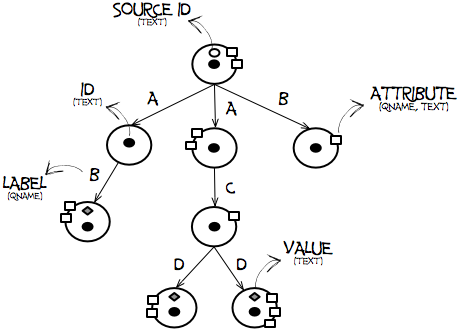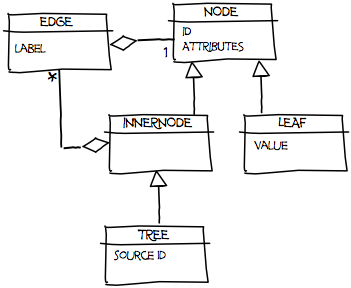The Tree Library
The Tree Library implements a model of edge-labelled trees, and related tools. It is a shared dependency for the components of a subsystem that provides data access under this model, including the Tree Manager services, the Tree Manager Framework, the Tree Manager Library and its clients.
The library is available in our Maven repositories with the following coordinates:
<groupId>org.gcube.data.access</groupId> <artifactId>trees</artifactId> <version>...</version>
Source code and documentation are also available in the repositories as secondary artefacts with classifiers sources and javadoc, respectively:
<groupId>org.gcube.data.access</groupId> <artifactId>trees</artifactId> <classifier>sources</code> <version>...</version> <groupId>org.gcube.data.access</groupId> <artifactId>trees</artifactId> <classifier>javadoc</code> <version>...</version>
Trees
The library implements a model of node-attributed, leaf-valued , edge-labelled, and directed trees. In particular:
- nodes may have an identifier and a number of uniquely named attributes;
- edges have a label;
- leaves may have a value;
- roots may identify the source of origin.
Moreover:
- identifiers, attributes, and leaves have text values;
- attribute names and labels may be namespaced.
The model is implemented in code by the following classes:
Nodes are either InnerNodes or Leafs. InnerNodes have zero or more Edges, each of which has a label and target Node. Attributes and identifiers are common to all Nodes, while only Leafs have values. Trees are InnerNodes with source identifiers, and serve as tree roots.
Instances of model classes are mutable, in that we can:
- add and remove attributes and edges;
- change the value of attributes and leaves;
- change source identifiers;
Note however that node identifiers and edge labels are assigned at creation time and cannot be changed thereafter.
We can also:
- compare instances for equivalence (instances override
equals()); - use them as keys in hash-based structures (instances override
hashcode()); - publish their state for debugging purposes (instances override
toString()).
Building Trees
We can construct trees in a standard object-oriented fashion, using any of the overloaded constructors common to all model classes (including copy constructors), e.g:
Tree tree = new Tree("rootId"); tree.setAttribute(new QName("x"),"..."); tree.setAttribute(new QName("http://foo.org","y"), "..."); tree.setSourceID("sourceId"); Leaf leaf1 = new Leaf("id1"); leaf1.value("..."); Leaf leaf2 = new Leaf("..."); leaf2.value("true"); Edge e1 = new Edge(new QName("a"),leaf1); //unqualified Edge e2 = new Edge(new QName("http://bar.org","b"),leaf2); tree.add(e1,e2)
Overloaded constructors simplify object creation, e.g.:
Tree tree = new Tree("rootId", new Edge("a", new Leaf("id1","...")), new Edge("http://bar.org","b", new Leaf("id2","..."))); tree.setAttribute("x","..."); tree.setAttribute("http://foo.org","y","..."); tree.setSourceID("sourceId");
We find details on individual constructors and mutators in the in Javadoc documentation.
Alternatively, we can adopt a more functional style, importing the static builder methods of the Nodes class and composing them in inlined tree expressions, e.g:
import static org.gcube.data.trees.data.Nodes.*; … Tree tree = attr(t("sourceId","rootId", e("a","..."), e(q("http://bar.org","b"),"...")), a("x",1),a(q("http://foo.org","y"),"..."));
The functional style is far less verbose, and is particularly suited for testing. t(), a(), e(), and q() are examples of Node, attribute, Edge and QName builders, respectively. We use them to avoid the new operator for those types. They also perform object-to-string conversions.
We show some further sample expressions below, while details on all the available builders are in the Javadoc documentation of the Nodes class:
//child-less root: t() is a tree builder Tree tree = t(); //with identifier tree = t("id1"); //with identifier and provenance tree = t("source","id1"); //with a simple child: e() is an edge builder tree = t(e("a",1)); //with a qualified edge label: q() is a QName builder tree = t(e("http://acme.org","a",1)); //with a second, identified simple child: l() is a leaf builder tree = t( e("a",1), e("b",l("id2","foo"))); //with a complex child: n() is an inner node builder tree = t( e("a", n( e("b",1)))); //with attributes: a() is an attribute builder, attr() is attribute-decorator for nodes tree = attr( t(....), a("a1","3"), a(q("http://acme.org","a2"),"foo")); //with an attributed child tree = t( e("a", attr(l("foo"),a("b1","3"),a("b2","bar"))));
We can of course mix object-oriented and functional style.
Inspecting and Traversing Trees
We expect and traverse trees procedurally. Given any Node, we can:
- inspect its identifier (
id()); - inspect its attributes(
attributes(),attribute(QName),attribute(String),hasAtttribute(QName)); - move to its parent
Node, if any exists (parent()); - inspect its ancestors (
ancestors(),ancestorAndSelf())
Note that, for convenience, all methods that take QNames are overloaded to accept unqualified names, as well as (namespace,local name) pairs;
For an InnerNodes we also can:
- inspect its children (
children(),children(QName),children(Class<? extends Node>), <code>children(Class<? extends Node,QName>)); - move to its children (
child(QName),child(Class<? extends Node>,QName)); - inspects its descendants along paths of edge labels (
descendants(),descendants(QName...),descendants(Class<? extends Node>,QName...)); - move to its descendants along paths of node identifiers (
descendant(String...),descendant(Class<? extends Node>, String)); - inspect its edges (
edges(),edges(QName)); - move along its edges (
edge(QName),hasEdge(QName)); - inspect the labels of its edges (
labels(),labels).
Note that:
- methods that return non-
Listvalues fail with anIllegalStateExceptionwhenever resolution is ambiguous, e.g.child(QName)fails if there is more than one child under an edge with input label;
- methods that take
Class<? extends Node>parameters filter the output to contain onlyInnerNodes orLeafs. For fluency, the constantsNodes#NandNodes#Lcan be used in lieu of, respectively,InnerNode.class,Leaf.class, e.g.:
import static org.gcube.data.trees.data.Nodes.*; ... Node n = ... List<InnerNode> complexChildren = n.children(N); Leaf leaf = n.child(N,"a").child(N,"b").child(L,"c");
- all methods that take
QNames access regular expressions, both on the namespace and the local name of the label, e.g.:
import static org.gcube.data.trees.data.Nodes.*; ... Node n = ... List<Node> bChildren = n.children("b.*");
Finally, we can:
- inspect the value of a
Leaf(value()); - inspect the provenance of a
Tree(sourceId()); - inspect that label of an
Edge(label()); - move to the target
Nodeof anEdge(target()).
Some further examples:
import static org.gcube.data.trees.data.Nodes.*; Tree tree = attr(t("1", e("a",l("2",5)), e("b",attr( n("3",e("c",4)), a("foo",0))), e("c",5)), a("x",0)); //typed children String val = doc.child(L,"a").value(); //typed descendant String val2 = tree.descendant(N,"3").child(L,"c").value(); for (InnerNode node : tree.children(N)) for (QName l : node.labels()) //process label for (Node n : tree.descendants("b","e")) for (Edge siblingEdge : n.parent().edges()) if (siblingEdge.target()!=n) //process sibling of descendant

